Is Fairchild Botanical Garden In Miami Open After Hurricane Irma
May 25, 2019
Visiting the Fairchild Tropical Botanic Garden
Whenever I travel, I always try to fit in as much as I can - I love visiting new places that are both informational and inspirational.
My busy day in South Florida also included a brief tour through the Fairchild Tropical Botanic Garden, an 83-acre museum, laboratory, learning center, and conservation research facility with extensive collections of rare tropical plants including palms, cycads, flowering trees, and vines. Fairchild is among the premier conservation and education-based gardens in the world and has been open to the public since 1938.
Enjoy these photos. I wish you all a safe and enjoyable Memorial Day weekend, as we celebrate the summer season and remember those who died while serving in our country's armed forces.
-
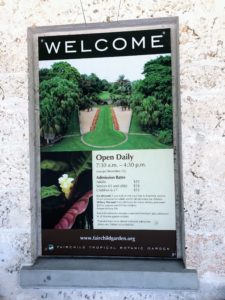
- The Fairchild Tropical Botanic Garden is located in the city of Coral Gables, just south of Miami. The garden was established in 1936 by Robert H. Montgomery, a successful businessman with a passion for plant-collecting. Montgomery named the garden after his friend and plant explorer, David Fairchild, whose travels brought more than 20-thousand plants to the United States.
-
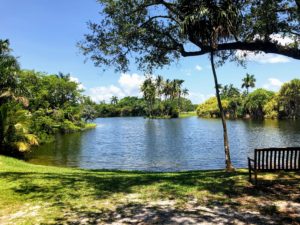
- The land on which the Garden was created included the upland with a strong slope that was up to 200-feet wide and the lowland or marine salt flat area. This space features an Overlook showing Pandanus Lake, the Pandanus trees bordering the south side of the lake and palms on the north and east end – such a gorgeous view.
-
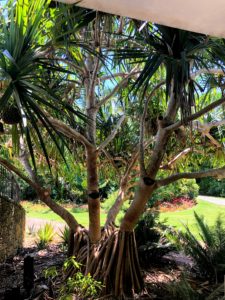
- Pandanus is a genus of about 750 accepted palm-like, dioecious trees and shrubs native to the Old World tropics and subtropics. The species vary in size from small shrubs less than three-feet to tall, medium-sized trees about 65-feet, with a broad canopy, heavy fruit, and moderate growth rate. The tree's thick stilt roots form a pyramidal tract that supports the stout trunk near its base.
-
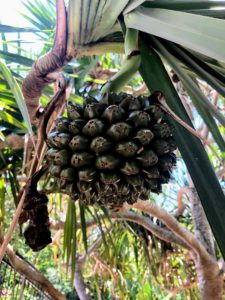
- Pandanus fruit consists of segments called cones or keys. Each fruit may have more than 100-keys. The juice tastes like a mixture of sugar cane and mango with a thick nectar-like texture.
-
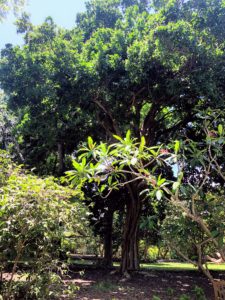
- This is a Plumeria tree near the Arboretum Plumeria. Plumeria is a genus of flowering plants in the dogbane family, Apocynaceae. Most species are deciduous shrubs or small trees. The species are indigenous to Mexico, Central America, and the Caribbean, and as far south as Brazil and north as Florida. The Plumeria tree is a fast-growing tropical plant producing masses of fragrant blossoms between March and October.
-
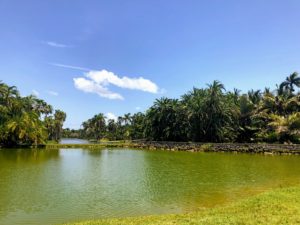
- This is Glade Lake with a land bridge leading to the Amphitheater in the distance. Glade is one of 11 lakes at Fairchild.
-
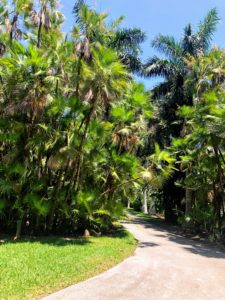
- A tram path towards Fairchild's rainforest allows easy access to the many scenic locations within its two acres. A meandering stream with waterfalls and cascades flows throughout many areas of the rainforest. The stream is fed by water that is pumped from Glade Lake and then gravity fed down the stream bed until it flows back into the lake where it is recycled.
-
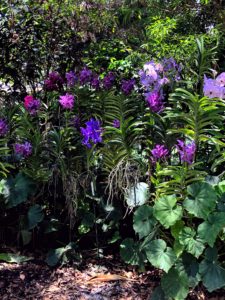
- We saw some beautiful hanging orchids – part of Fairchild's National Orchid Garden, the first of its kind. It contains the largest public outdoor display of tropical orchids in the United States. In fact, in 2012 Fairchild also became the home of the American Orchid Society.
-
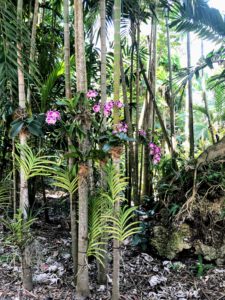
- Vanda orchids are also part of Fairchild's National Orchid Garden. Vandas are mostly warm- and full-sun-growing plants with colorful flowers. These blooms are in shades of pink.
-
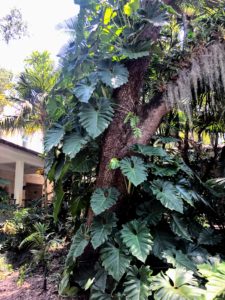
- These are epiphytic aroids on a live oak tree outside the Science Village Building. Aroid is the common name for members of the Araceae family of plants, sometimes known as the Philodendron or Arum family. No other group of plants can compare to the extravagant and exotic foliage exhibited by Araceae. Leaf blades are very wide, ranging in size, shape, and color.
-
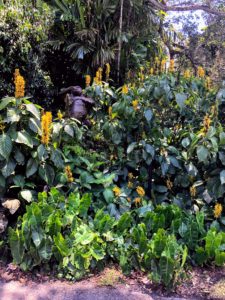
- This is a yellow shrimp plant, Justicia brandegeana. It is well-liked because of its vibrantly colored bracts. Justicia brandegeana originates from Mexico. The genus, which has more than 400 different species is named after James Justice, a Scots gardener and author of a 1754 book, "British Gardener's Directory." The species is named for a famous American botanical explorer, Townsend S. Brandegee. It is commonly called a shrimp plant because each spike somewhat resembles a large shrimp.
-
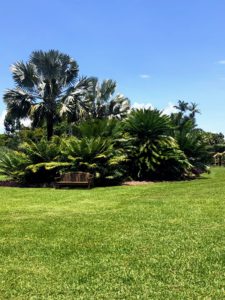
- Also at Fairchild – a stunning collection of cycads. I love cycads and also keep many specimens at my Bedford, New York farm.
-
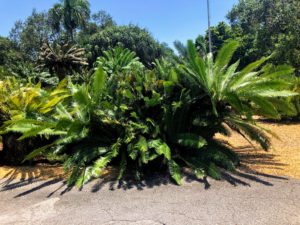
- Cycads vary in size from having trunks only a few centimeters to several feet tall. Cycads typically grow very slowly and live very long, with some specimens known to be as much as a thousand years old.
-
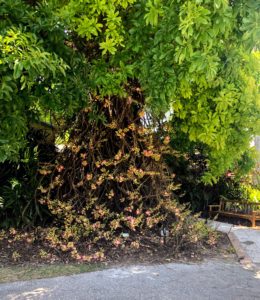
- This cannonball tree sits outside the Montgomery Building. Skirted Cannonball, Couroupita, Guianensis has salmon pink and lemon yellow colored flowers that bloom directly from the trunk. Mature trees are capable of producing more than 800-flowers in a day. This tree also produces spherical woody fruit that resembles rusty cannonballs. This specific tree is well over a century old!
-
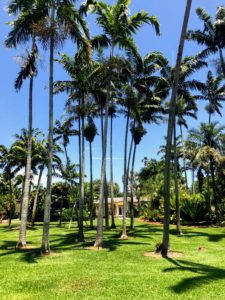
- These stately palms are in the Montgomery Palmetum at Fairchild. The Montgomery Building is in the background. The Montgomery Palmetum is a world-renowned botanical display and research collection of palms from all parts of the world and is generally recognized as the most important documented palm collection on earth.
-
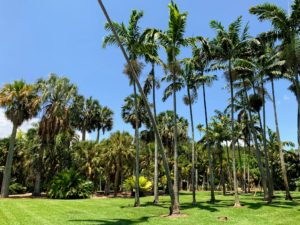
- The Montgomery Palmetum is 13-acres large and displays at least a thousand palms.
-
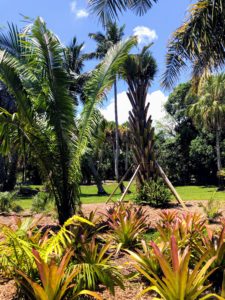
- Look closely to see this palm supported by crutches, most likely propped up after Hurricane Irma in 2017.
-
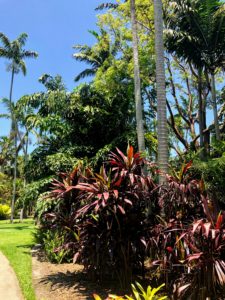
- This is a Ti plant. Ti plants come in a wide variety of colors, including green, red, chocolate, pink, orange, variegated and combinations of all of these. They grow in a tiered rosette and do not often flower.
-
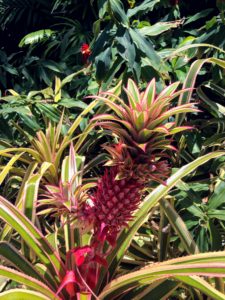
- You may recognize this – an ornamental pineapple. This is a bromeliad grown more for its foliage, not for its fruit. The gorgeous bright red, green and cream striped leaves are held rigidly off a low stem. Their bright fruit is attractive but rather bitter. The plants make lovely and interesting houseplants, or warm season potted outdoor plants.
-
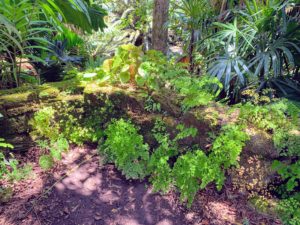
- This ledge overlooks Fairchild's Sunken Garden. It's covered in maidenhair ferns and begonias.
-
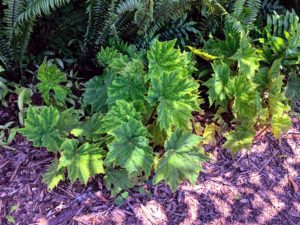
- Here is a closer look at some of the begonias – they are all thriving in this environment.
-
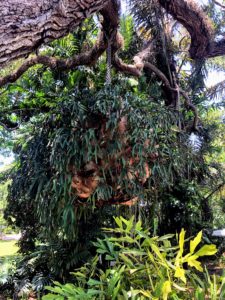
- Nearby, we saw this massive staghorn fern hanging from a live oak tree limb – it is so huge and beautiful.
-
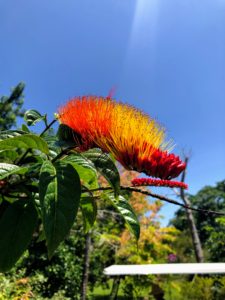
- This is called monkey brush, Combretum aubletii. Monkey brush, or monkey brush vine, is an exotic plant native to South America. Monkey brush has flowers that change color from yellow to a deep orange-red.
-
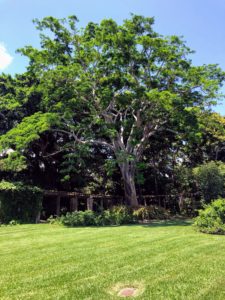
- And here is Fairchild's tallest tree, Albizia niopoides var. niopoides, collected by David Fairchild himself. This type of tree grows up to 100-feet tall with a wide-spreading crown – so stunning. Fairchild Tropical Botanic Garden has magnificent collections – please visit the next time you're in South Florida – you'll love it.
Is Fairchild Botanical Garden In Miami Open After Hurricane Irma
Source: https://www.themarthablog.com/2019/05/visiting-the-fairchild-tropical-botanic-garden.html
Posted by: hortonegary1939.blogspot.com

0 Response to "Is Fairchild Botanical Garden In Miami Open After Hurricane Irma"
Post a Comment